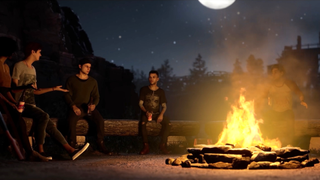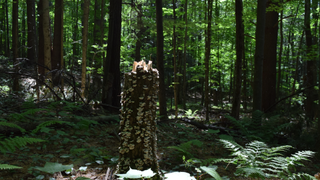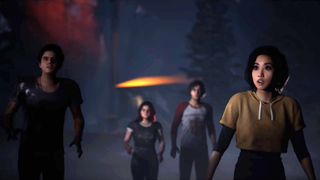The scariest thing about The Quarry is that it's near my house
Wild fog

Mobile phones are a constant problem for horror movies, and so it's yawn-inducingly common to see a story begin with some strained premise designed solely to remove them from the film's world. It's hard to maintain dramatic tension, much less a sense of real horror, if the characters can just call for help at any time or, in a pinch, look up some how-to videos on YouTube. It's no surprise then to see that The Quarry, Supermassive Games' latest celebration of trashy teen horror movies of the '90s, begins in much the same way. The teenage counselors we follow through Hackett's Quarry have had to surrender their phones at the start of summer camp, but quickly discover that there's no cellular service in upstate New York anyway.
It’s a choice that keeps with tradition and allows The Quarry to pull ideas from classic shlock franchises like Friday the 13th. But as it turns out, it's an entirely accurate one. Supermassive has clearly done its homework, and while Hackett's Quarry is a fictional location, there are plenty of clues throughout The Quarry that place it definitively in a real-world region: New York's Catskills mountains.
I've lived in upstate New York for most of my adult life, and I've been impressed by how well Guildford, UK-based Supermassive has managed, often with impressive subtlety, to capture the regional atmosphere. My memories of teenage summer are of going to scout camp in the Adirondack mountains that cover the northern quadrant of the state – and which form the largest state park and protected wilderness area in the continental United States.

Geologically speaking, the Adirondacks are ‘new’ mountains, shaped by relatively recent tectonic elevation and erosion that began around 20 million years ago. The Catskills, where The Quarry takes place, are much older – and were carved by ancient streams that flowed over the area 200 million years ago. The Catskills overlook the Hudson Valley as you travel north from New York City, guarding the rise to the state's central plateau most of the way up to Albany, and west as far as Delaware and Otsego counties.
The distinction between the Adirondacks and Catskills shows up right away in The Quarry, and it threw me off at first. As we're introduced to Hackett's Quarry in the first act, the setting sun highlights large deposits of reddish rock, which seemed incongruous to me. During my rambles on trails up in the Adirondacks, I'd mostly seen the dark grey and blue stones that dominate that range – red seemed out of character for a location in upstate New York. But actually, that red hue can be seen in the rocks alongside streams – and in the cuts and fills around the winding highways – down in the misty Catskills.
Kill state
Another clue that The Quarry takes place in this area can be found in North Kill, the name of the fictional county where Hackett's Quarry Summer Camp can be found. While 'North Kill' certainly works as a thematic device for a teen slasher game, the kill bit of the name is a common suffix in the Catskills. It's derived from an old Dutch word for a creek or stream, and it's appended to the names of countless places in the area, which was once part of the 17th-century Dutch colony of New Netherlands. There's West Kill, Beaver Kill, Vernooy Kill State Forest, the town of Cobleskill up near Albany, and dozens of little brooks and hamlets and hollows across the region that have names containing the word 'kill'.

While that sounds ominous – and the Hackett's Quarry Summer Camp counselors probably should have taken the warning – it's really just a holdover from the era when New York City was known as New Amsterdam.
Get daily insight, inspiration and deals in your inbox
Get the hottest deals available in your inbox plus news, reviews, opinion, analysis and more from the TechRadar team.
If you're not from New York, it's hard to overstate how utterly different the city is from the Catskills region, and from most of the rest of the state, for that matter. You can pick up US Highway 9 on the Manhattan side of the George Washington Bridge and head north through the Bronx, over the Harlem River, up out of the city, and through Sleepy Hollow. As you continue north, you'll see the mountains grow on the west side of the Hudson, which you'll cross at the Bear Mountain Bridge.
The dense skyscrapers and bustling avenues of Manhattan are a distant memory. You are in The Woods now, and the rules are all different
At this point, the dense skyscrapers and bustling avenues of Manhattan are a distant memory. You are in The Woods now, and the rules are all different. There's another hour to go to reach Kingston, and that's where you'll pick up Highway 28, which will take you through the heart of the Catskills: Mount Tremper, Phoenicia, Shandaken, and Margaretville, then cutting north at the Pepacton Reservoir through the Andes before you reach the picturesque little town of Delhi, situated along the Catskills' northern edge.

Anyone who makes this drive will discover what Laura and Max do in The Quarry's opening scene: that it's a winding, sometimes treacherous road where it can be difficult or impossible to keep going in any one direction for very long. The highway follows the curving streambeds between the Catskills' many ridgelines and peaks, all of which are covered in dense forest. The valleys often fill with fog, and at night it can be very difficult to find your way around – or stay on the road.
New York, Old World
This is God's Country, in every sense of the word – the largest buildings you'll find along this route are old churches (generally United Methodist and Presbyterian) and weathered wooden barns. Many of these still have six-pointed stars known as 'hex signs' painted above their main doorways, meant to ward off sickness, fire, famine… or some other unknown darkness that lurks beyond the treelines at the edges of remote Catskills farms. Hex signs are another telltale indication of the old Dutch influence on the region, and while they've taken on friendlier meaning in modern times, certain Mennonite and Amish communities have banned their use, as they hold ties to ancient pagan superstition brought over from the dark forests of the Old World.
The labyrinth of valleys, ridgelines, draws and spurs means mobile phones are of little help when it comes to finding your way around. So, yes: nobody at Hackett's Quarry would have been able to use a cellphone to call for help, and Emma would have had to wait to upload her dishy vlogs from that fateful evening.

All the cars in The Quarry belong to a certain vintage: Max drives a station wagon with faux wood paneling inspired by the 1980s Chrysler LeBaron Town & Country wagon and the 1987 AMC Eagle, while the camp van (which Jacob sabotages to buy an extra night at the site) looks like an '80s Chevy G10. While not all the vehicles you'll see in the real Catskills are that vintage, it's certainly not uncommon to see 30-year-old cars on and around the mountain roads: this is an area that gets a lot of snow, which means there's lots of rock salt on the roads for almost half the year. Knowing the corrosive damage this stuff does to vehicles, many folks in upstate New York opt to drive their cars until the wheels fall off rather than buy a new one that's just going to start rusting in a couple of years.
Meanwhile, the Hackett's Quarry lodge is another pleasant nod to local history. While we don't get a full view of the lodge in The Quarry, what we do see indicates a multistory structure with a massive peaked roof, done in a grand 'rustic' cabin style. The design of the building is a nod to the ‘great camps’ built throughout the Adirondacks by captains of industry and prominent politicians in the late 1800s. Prospect Point Camp, situated on the banks of Upper Saranac Lake and built in 1903 for financier and copper magnate Adolph Lewison, is a perfect example of the trend: a massive main lodge, set far from civilization, but fully equipped with amenities like electricity, flushable toilets, and a staff. White Pine Camp, built far to the north in the hamlet of Paul Smiths, even served as the ‘summer White House’ during the Calvin Coolidge administration.
Hack it
The Hackett's Quarry lodge is designed with these extravagant Gilded Age campsites in mind. There's the large great room at the center of the building, which features timber-beam construction and plenty of antlers on the walls. Enough bedrooms to house everyone in the family and a battalion of guests line the halls, and there's a well-appointed kitchen to make sure nobody has to subsist on the local berries and game. It looks just like the main house at Great Camp Sagamore, a stunning and lavish retreat for one of New York's wealthy Vanderbilts.

To my knowledge, of course, none of these great camps had secret underground bunkers for cryptid research attached to them, but then again, that's not the kind of thing that's usually included in the visitor's tour. Bunker or no, these are exactly the kinds of families and the kinds of houses that would be extremely haunted: there's no telling how many double-crossed business partners, jilted lovers, abandoned miners, secret families, and exploited workers would be eager to get their revenge on these robber barons, in this life or the next.
You can always head out on the trails, where you may encounter one of 2,000 or so black bears in the area
Assuming you can keep clear of the ghosts, you can always head out on one of the Catskills’ many hiking trails, where you may encounter one of the 2,000 or so black bears that live in the area. Dylan is quick to assume that anything The Quarry's counselors encounter is a bear, and it turns out he's not far off base. About a third of New York State's bears live in the Catskill park, and so sightings are not that uncommon in the area.
There are a few other delightful Catskills details The Quarry gets right: the cartoon tutorial segments, presented in the style of 1960s-era safety cartoons, line right up with much of the state park signage you'll find at trailheads around the region. As you set off up Devil's Path, the area's most difficult hiking trail, you'll find a sign-in box fixed to a tree just up from the small parking area. Inside, there's a pad of government forms where visitors can use a worn-out golf pencil to record their names and addresses, and indicate when (and if) they've successfully returned from the 9,000-foot ascent that covers almost 22 miles of steep, rocky woodland. The sign on the box features a friendly cartoon hiker making his way into the woods, and he looks like he'd fit right in with The Quarry's stylized tutorial clips.

Supermassive has shown impressive attention to detail in The Quarry, and yet… something still feels a bit off. There's something about the lay of the land (too flat!), the density of the forest (not enough little saplings), and the quality of the sunlight in the game that never quite feels familiar. There should be more pine needles on the ground, more blackflies in the air, and the smells of old canvas and campfires as you walk outside.
Of course, the reason for those divergences is obvious. The Quarry isn't really about upstate New York or the Catskills mountains. These form a rich backdrop for its story, but its story and its characters are an homage to movies, not to places or cultures. You don't need to have ever visited this place to enjoy your harrowing time at Hackett's Quarry. For those of us who have, though, The Quarry casts a pleasantly welcoming nod.
